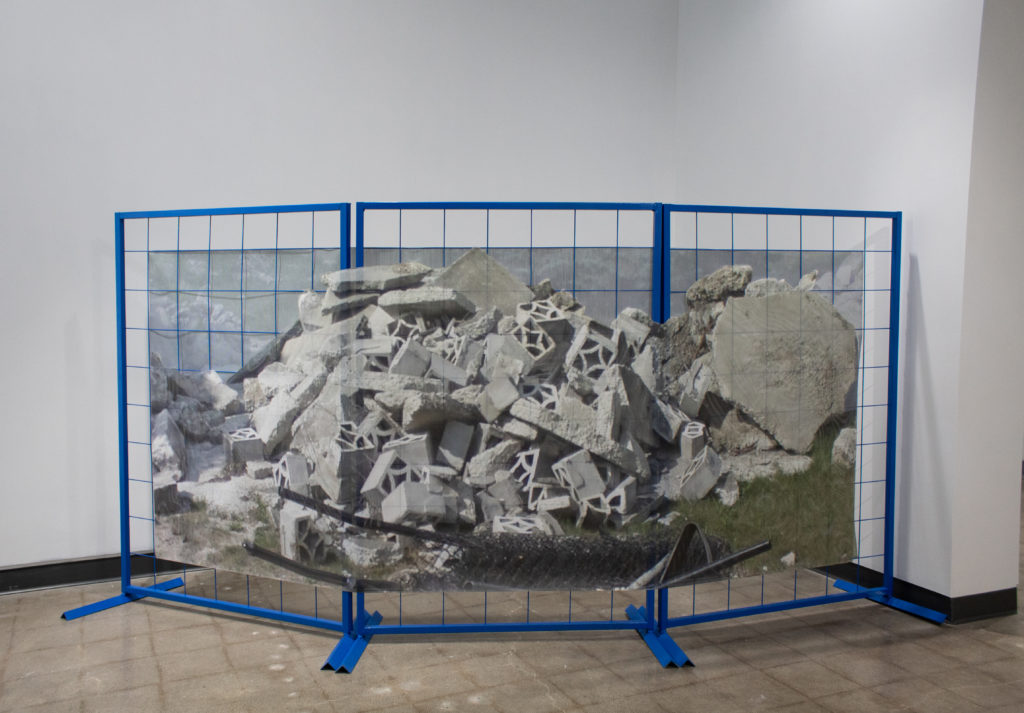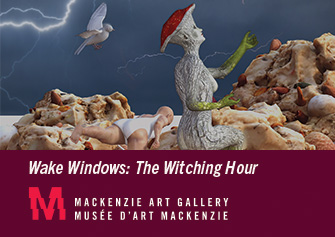Walking Through Nonsuch: A Conversation with Morgan Melenka
18 June 2023By Nadia Kurd

Calgary-based artist Morgan Melenka’s practice consistently sources from the expansive fields of sculpture, architecture, and printmaking. In her work, Melenka researches and links the histories of material to place—like American-made Formica for example—and in doing so, expands and contextualizes the wider implications of their various uses through her creative approach.
In her past solo exhibition Nonsuch at SNAP Gallery in Edmonton, Melenka investigates a small section of Edmonton’s Griesbach neighbourhood, bringing together sprawling histories that encompass British colonial expansion, architectural conventions, and the mid-century prevalence of mass-production. The multimedia works in this exhibition combine construction fencing, Formica, and Google Street View images. By using the street name ‘Nonsuch’ as the basis of her exhibit, she highlights the ways in which certain architectural built-forms have shaped the city of Edmonton. Through this exhibition, Melenka highlights how these structures have since become commonplace; their histories normalized and often taken for granted simply because they appear almost everywhere in the city’s newer subdivisions. The subtlety of Melenka’s works speaks to the greater narratives that are often overlooked in the development of suburban histories.
In our conversation, we discussed how this project has evolved and culminated into the exhibition Nonsuch, which showed at SNAP Gallery from June 18 – July 23, 2022 in Edmonton, AB.
Nadia Kurd: You grew up in Edmonton, but came across the northside neighborhood of Griesbach as a seasonal worker during the 2010s, and noticed the new developments in the area. Can you describe the early phases of your research? What initially drew you to the name of the street and its history?
Morgan Melenka: Yes, I grew up in west Edmonton and because the city is so large there were many areas I didn’t discover until adulthood. Through a summer job in my early twenties (incidentally, pulling weeds in parks) I learned much more about the north end, which has some interesting intersections between light-industrial and residential housing. For the most part, this area has more established communities, with a few newer ones closer to St. Albert. Griesbach stood out because this neighborhood is a giant infill of land1 that was converted from an army base.
I kept thinking about Nonsuch Street after visiting it through work, and I talked about it consistently for a while. It was a strange collection of ruins: there were ordered piles of concrete and construction debris under functional street lights, containing intact toilets, bits of fence, etc. There was also recent, and clearly illegally, dumped materials. The ruins seemed stable, like they had been there a while and had a matter-of-fact air about them. This did not seem like an active construction site where buildings were being ripped down and replaced, but rather this area was overgrown, but still tended to. I would guess these piles of former houses had been arranged at least five years prior, maybe longer.
One evening, I returned there with my partner Alex [Linfield] and he photographed the piles because he also found them interesting. When I went to grad school some years later, I was still thinking about them. While I was reading Learning from Las Vegas2 and thinking about themed and image-based experiences of space, I held this pocket of Edmonton in mind. It seemed contrary to my interest in Postmodern architecture and our current pastiche approach to history in architecture, and yet I felt that this ruin offered a familiar experience to me.
I made little sculptures that used the image of these ruins and tried to figure out what they meant. Over time, I nick-named these objects and simply referred to the models as the “rubble pile” knowing they somehow fit in with my other works. In my final year of grad school I was finally able to articulate that this pile of concrete was familiar for its sense of fabrication—it felt like an architectural folly of a ruin, rather than a real ruin. This was familiar to me through experiencing spaces such as West Edmonton Mall and Caesar’s Palace in Las Vegas.
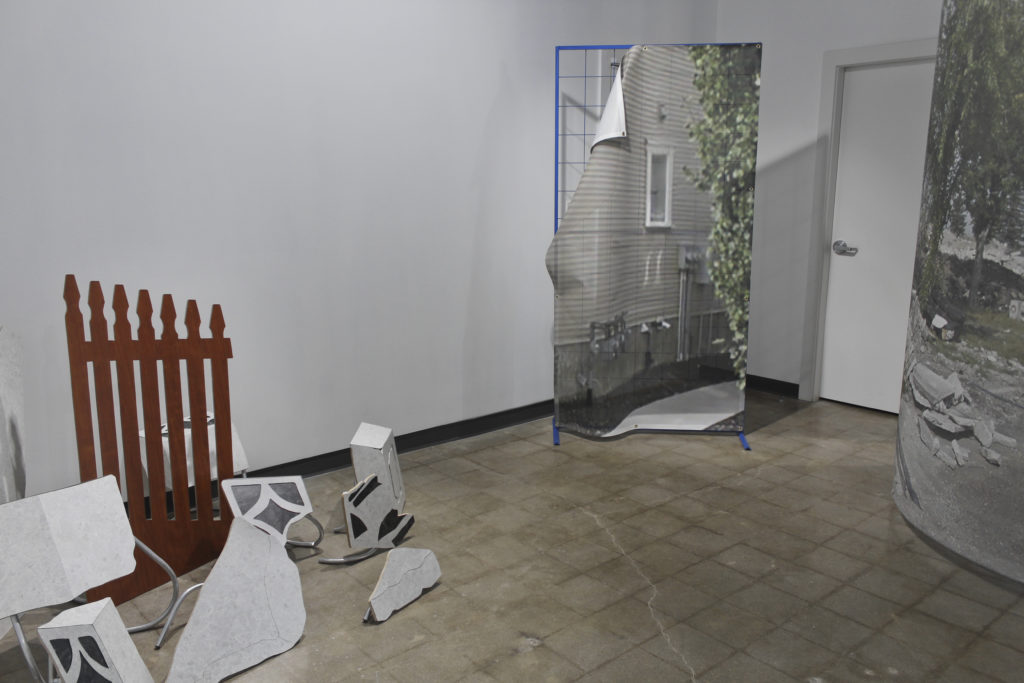
During repeated visits to the road on Google Maps, I rediscovered the name and was captivated—how did this seemingly fake ruin have the name Nonsuch? Incredible! It was itself a nonplace; [a place] out of time, containing remnants of houses that were less than a century old. To add to the anachronism of this, the neighborhood in which it stands was once a military base and when this land was acquisitioned by the Canada Lands Company in 2001, the developers of Griesbach had the opportunity to build a new neighbourhood in an older area of town and make something stylistically consistent. Instead, the developers chose to call it “the Village at Griesbach,” and stipulated that all houses in the development must follow historical building styles.3
NK: This project seems like a natural progression for you in terms of materials, methods, and a line of inquiry, yet, in many ways, you have also departed from conventional printmaking and have pushed how you have displayed your work in the past. Can you describe what changed for you with this exhibit?
MM: I think you’re right, it does feel like a progression that made sense. In my undergrad I visited a commercial print shop on a class trip, which introduced me to thinking about contemporary print uses in city spaces. We saw screen printing exposure units the size of a room and large format digital printers at least twenty-feet long. Large format advertising had been something I took for granted as outside of “art” and so I looked at this with fresh eyes.
I found printed mesh vinyl when looking closer at city spaces—it shows up mainly on construction fences to advertise new builds and shield unseemly construction sites. The holes of the mesh (which also makes the material wind resistant) creates a beautiful translucent surface. The space behind it was never fully obscured, but like a reflective window, asks you to acknowledge both the surface and the depth behind it. I did a few experiments with this material before grad school and knew I wanted to further pursue the content of this commercially printed surface. Its translucency reminded me of gauzy painted theatre backdrops, and in my thesis show I used it as such. I printed three layers, two with images of the rubble pile and one of a lush garden, to function as the set for my sculptures, which I called Scrim Wall (2019).
After installing Scrim Wall I couldn’t stop thinking about how the piece behaved—yes you could see all layers subtly at once, but also the material created interference patterns against itself, much like when you photograph a computer screen. I needed to come back to this material and decided to propose a show that pulled at the threads of this one piece, expanding the scale to a whole gallery. While working through the show I decided that this airy material needed to be grounded by Formica sculptures. These elements behave as concrete, albeit entirely flattened, anchors of the rubble pile.
Nonsuch, while seemingly an exhibition of prints, is entirely sculptural. I felt that the works needed to be navigated, permitting the translucency of the mesh vinyl to provide opportunities for the works to overlap each other, depending on where the viewer stood.
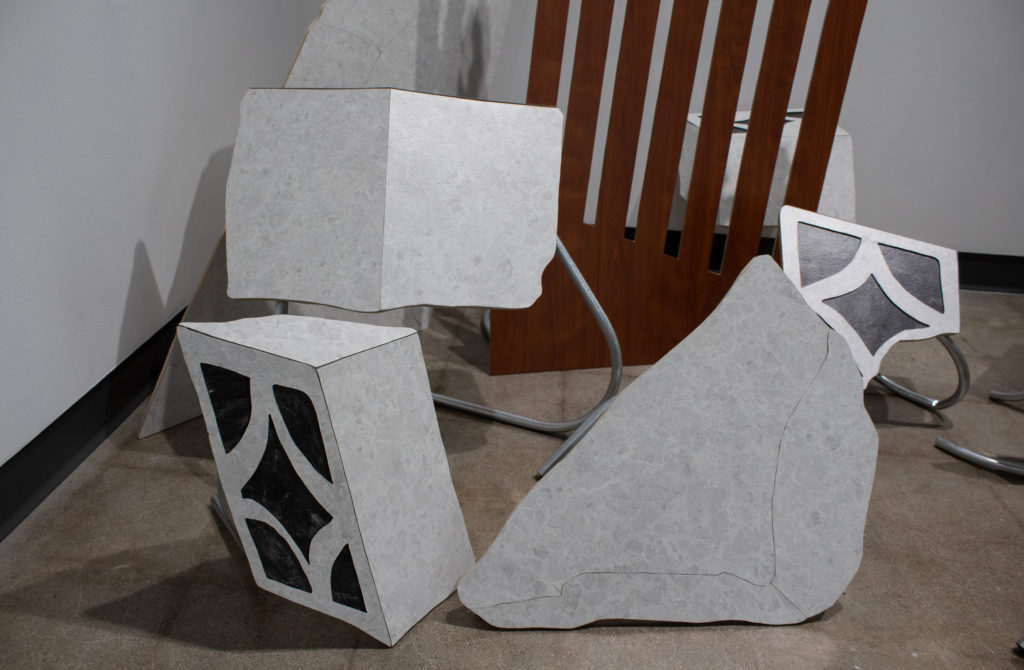
NK: One subject you’ve touched upon in our conversation is the intersection of architecture and the role it plays in conveying ideas and identities; what have been some of the overarching ideas that have gone into developing Nonsuch, or rather, have been present in the planning of the Griesbach neighbourhood? On a larger scale, how much of it is tied to capitalism and utopian ideas of suburban living?
MM: Totally, yes I think architecture is narrative, and, I see it as a permanent (or semi-permanent) reflection of cultural values. Large amounts of capital and labour are poured into creating buildings and as such they become emblematic of a certain period in time and how we approached organizing people—holding and moving them in space. Of course, while this is at the discretion of designers, what becomes popular is shaped by local and global demand. Embedded in these buildings is the very foundational thinking about how people should live and work, what our priorities are, etc.
In recent years, I’d guess in the last fifteen, a particular kind of historical imagery and references have appeared in both commercial and residential structures, which are still in vogue today. Manchester Square in Edmonton is a great example of this: it’s a small shopping centre, which if it were built twenty years ago, would have been a dull strip mall. Instead, today it seems to reference buildings in Amsterdam (but maybe these are an excellent recreation of Manchester style buildings, I can’t say since I’ve never been).
The attention to decorative brick patterning is charming and the detail and variation makes this shopping area stand out. This also exemplifies what has happened at the new Griesbach development. The former army base was rezoned and approved for redevelopment in the 2000s, and due to its status as a historical location knowingly uses the tagline “Edmonton’s Most Beautiful Community: Built with History, Built to Last.”4
These particular kinds of historical architectural styles imitated in modern materials skew heavily to old English/European; we are seeing references to Victorian and Queen Anne styles from the late 1800s. Griesbach adheres to style guides that explicitly articulate this. The five ‘acceptable’ building styles of new homes in the neighborhood are: Victorian, Tudor, Colonial, Craftsman, and Prairie. It’s notable that all except Prairie originate in England, and that Tudor, Colonial, and Victorian don’t really have a place in Edmonton’s architectural history.5
This is a strange utopian vision in my mind—people seem to uphold historical forms as more beautiful and worthy of our attention, especially as these historical styles give permission for ornament (such as columns and scallop shakes), over the white cube style of modern condo towers. What’s of interest to me is that in so-called Canada, as a former British colony and current member of the British Commonwealth, these brand new houses in Edmonton are still imitating the colonizer, the place that collected the wealth and resources extracted from the Indigenous communities. Is the utopian vision of suburbia a recreation of the land ownership and wealth of the British empire? This is a continued fetishization of England and our ongoing interest in supporting class divisions.
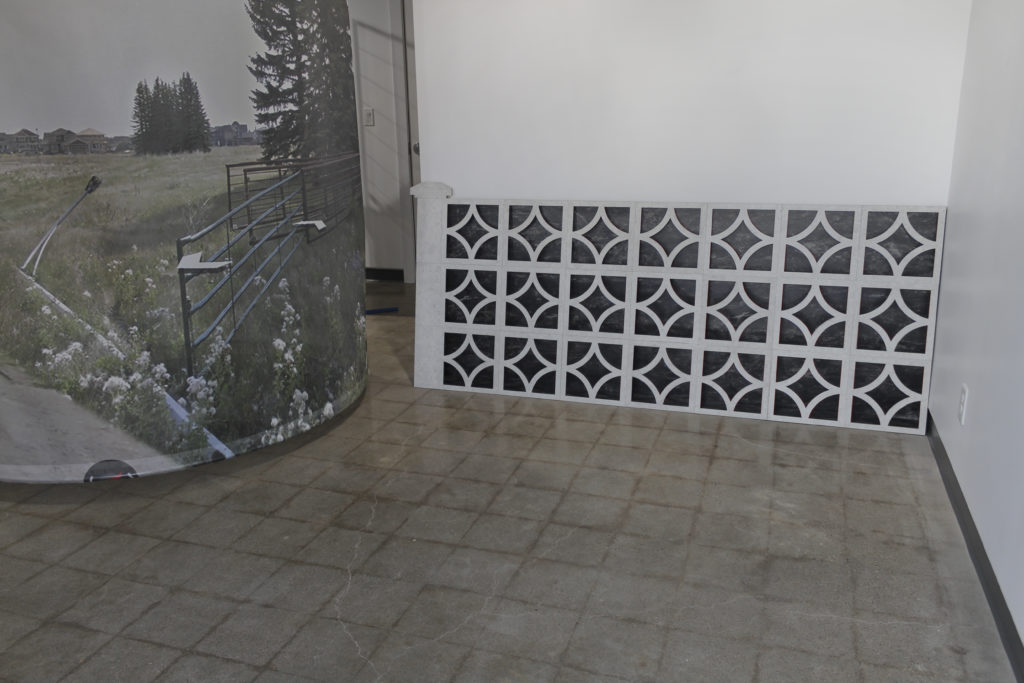
NK: Can we backtrack a little bit here Morgan? Can you tell me about how the employment of European historical architecture came about in the region? Have there been key urban developments that have used this to convey a sense of architectural authority?
It’s not a new process, Greek Revival was in vogue in 1820s America, Gothic Revival in Canada in the 1860s. But this particular historical reprisal is a product of Postmodern architecture, beginning in the late 1970s, and accelerated by its use in commercial buildings. I find Postmodern architecture fascinating—there is a sense of irreverence, an acceptance of novel uses of forms, such as irony, pastiche, faux-finishing, and colour.
However, the very format that borrowed so heavily from places such as Las Vegas are wrapped up into sites of capitalism. I like to think of the movie theatre in Calgary at Chinook Mall as an example, with its massive scarab beetles and Egyptian style lotus pillars. This architecture gave designers permission to again reference historic styles following a roughly forty-year hiatus after the stronghold influence that Modernism held. As time has passed, I see more buildings less ironically and more sincerely referencing British historical styles such as “Tudor,” as is the case with the Griesbach development. The houses and area referenced in Nonsuch, rather than give into playfulness and exaggeration, quietly emulate Tudor in a cos-play of history, attempting a seamless revision of history in the modern day through the assertion that not only does this kind of architecture make sense here, it belongs here.
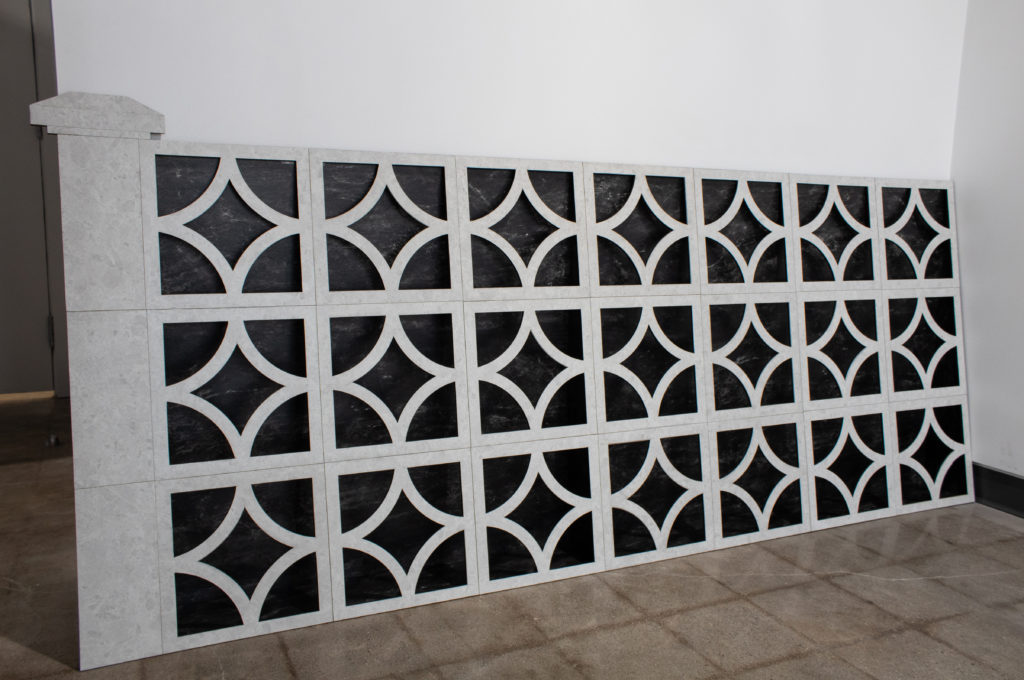
Nadia Kurd: In your research, and resulting exhibition, what were some of the hidden or little known links between urban planning, historical styles in architecture, and gentrification that you uncovered? How are they rediscovered in this exhibition, and what do you think this says about our local histories and how they are passed on?
Morgan Melenka: Oh good question! I recently learned that a Calgary-based company called Brookfield Residential6 builds new developments across Canada and many parts of the U.S, as far away as California and Delaware. This alone points to a homogenous approach to building residential spaces in North America, and looking at their various developments online, there is nothing exceptional about their houses that would signal whether the house is in Edmonton or Austin. This is an example of the erasure of local histories, as well as the removal of specificity at the hands of developers.
In 2016, when I was starting to inspect how architecture reflects our cultural values, I visited a new development in Edmonton called Tuscany Hills because I thought it absurd that a neighborhood in Treaty 6 would pretend to be Italian. Once there, I found every house was a mansion. There was a show home open for visitors, which I toured, and witnessed the most bizarre, cobbling-together of Italian-esque styles for maximum effect and showiness.
The literary critic and novelist Umberto Eco explores the idea that North America is in such a crisis of newness, and in fear of its own real (horrific) history, that it extracts history and fantasy from Europe as a means of legitimacy in his essay, “Travels in Hyperreality.”7 It seems that once a place in North America has enough wealth to emulate more wealth, the anxiety to express the right wealth takes over. This “right” wealth is legitimated by legacy, and therefore a Eurocentric culture continually looks to its own history. An example in the essay is Hearst Castle in California, where media mogul William Randolph Hearst demonstrated his cultivation by gathering together treasures from Europe and built his very own baroque castle.
Meanwhile, I’m a bit of a nerd for vernacular architectural styles, particularly as seen in Canadian cities. Canada Parks Service published a brochure in 1974, which I love, called The Buildings of Canada: A guide to pre-20th-century styles in houses, churches and other structures.8 This brochure gives a quick overview of how particular styles were employed and where, while paying particular attention to how ornament and detail were used in each example. Of particular interest to me in this booklet are the more modest, utilitarian structures that rely on local materials such as grain elevators, western-style store fronts with the false second floor, or salt box houses in the east.9 I also spend time researching various heritage and historical societies as they are a wealth of information on local building histories.
I suppose the link between historical styles and gentrification is that no new development wants to emulate the modesty of a prairie post-war bungalow.10 There is an incentive for new housing to be unreasonably large, and as people are paying an obscene amount for housing now, perhaps that’s part of the equation for why houses that recall the olden days of English land barons are in vogue.
Nadia Kurd: Thank you for taking the time to discuss Nonsuch, your work provides a critical entry point to consider what is at stake in this development and to the historical sources for some of the built-forms found in the city. There is a lot to consider here, especially since there seems to be a never-ending stream of land development and construction not just here in Edmonton, but across Canada. Any concluding thoughts for our readers?
Morgan Melenka: Nadia it’s been a joy, thank you for your thoughtful questions and for spending time with this exhibition.
I guess I have one last thought—I’ve heard that some of the issues linked to overly large or grandiose houses has to do with the subprime mortgage crisis beginning 2008, and because that issue was patched but still not fixed, has continued. But I also don’t understand enough to try to connect all the dots, or jump to conclusions. What I do know is that what is built into all these new constructions is an aspiration, a fantasy, and the period immediately prior to the 2008 market crash was literally about selling people on impossible dreams.
I grew up a few blocks away from West Edmonton Mall, where a bizarre hodge-podge of history, geography and sensational experience impressed itself into my conception of place-making. It was the fertile ground for me to see aspiration and fantasy as embodied in architectural space – and I can’t wholesale reject the spectacle. Did I feel lobotomized when I visited Las Vegas? Entirely. Do I understand why people crave escapism, especially on the cheap? Of course. Rather than shame us for liking the simulated environment, I want to understand how it got here in the first place, what is so compelling about its narrative, and why in architecture we cannot seem to let history lie.
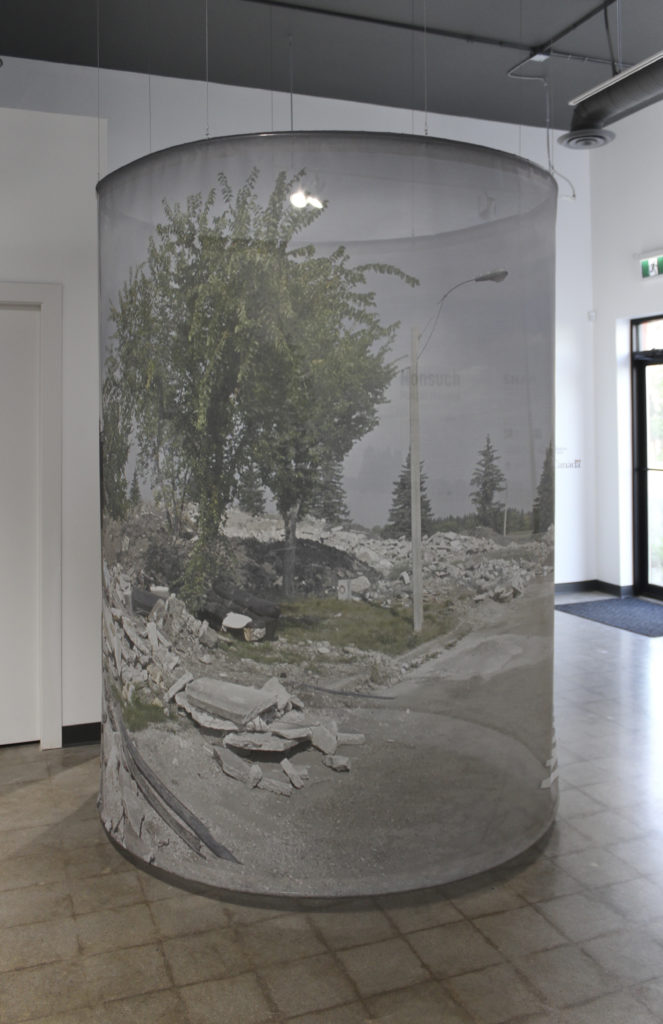
- See https://en.wikipedia.org/wiki/Infill
- Robert Venturi, Denise Scott Brown, Steven Izenour, Learning from Las Vegas, (Cambridge: MIT Press, 1972).
- https://edmontonjournal.com/news/local-news/the-lessons-of-griesbach
- https://villageatgriesbach.com/
- See here for what the developers think this means; and here for what the Edmonton Historical Board lists as popular styles.
- https://www.brookfieldresidential.com/
- https://archive.org/details/travelsinhyperre00ecou/page/n9/mode/2up
- Barbara A. Humphreys and Meredith Sykes, The Buildings of Canada: A guide to pre-20th-century styles in houses, churches and other structures, (Montréal: The Reader’s Digest Association, 1974).
- See various examples here, here and here.
- The Edmonton Historical Board defines them as such, and some good examples are portrayed in artist Hubert Hohn’s Edmonton Entrances and Suburban Landscapes, which showed at the Art Gallery of Alberta in 2018.
Nonsuch by Morgan Melenka ran from June 18 – July 23, 2022 at SNAP Gallery in Edmonton, AB.
Feature image: Installation view of Nonsuch by Morgan Melenka at SNAP Gallery. Photo by Devin Cypher courtesy of the artist.

